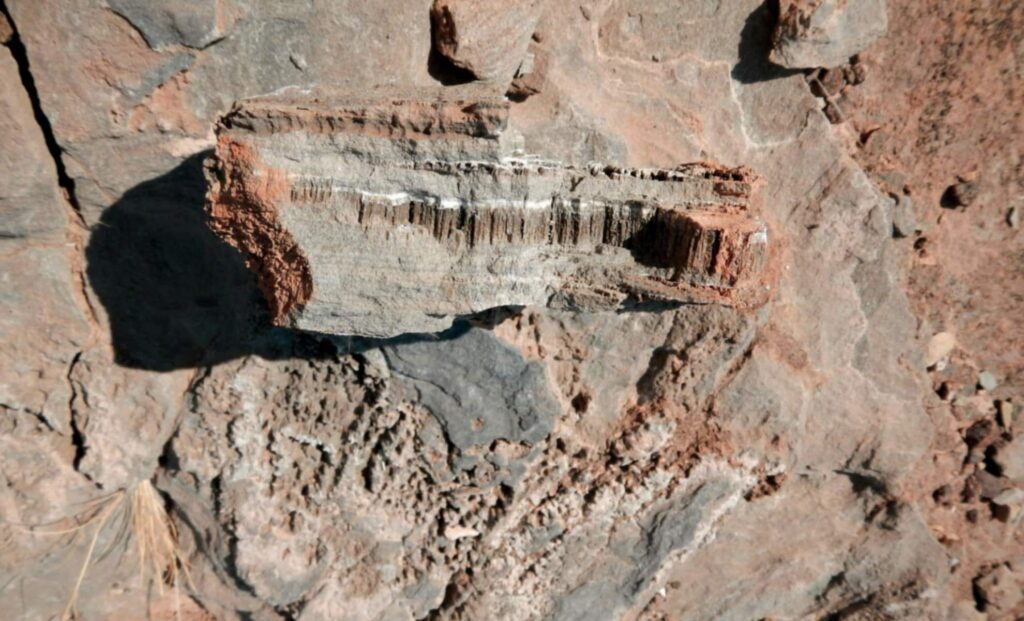Deep in the parched terrain of western Namibia, geologists have found something that challenges long-held assumptions about the Earth’s crust. Lining the inside of ancient marble formations are countless hair-thin tunnels, running perfectly parallel to one another for as long as ten meters. Carved into rock that dates back over half a billion years, these micro-burrows raise a confounding question: What could have created them?
The structures, found in the remote desert between 20 and 29 degrees south, were first documented by Professor Cees Passchier of Johannes Gutenberg University Mainz. Passchier made the discovery during a geological survey of Neoproterozoic marbles and limestones, rocks that were once marine sediments but have long since been folded, buried, and exposed by erosion over millions of years. “We were surprised because these tubes are clearly not the result of a geological process,” he said in a recent statement.
From Rock Fractures, A Pattern Emerges
The tunnels were first observed in Namibian marble, but similar formations have since been identified in Cretaceous limestone outcrops on the southern flank of Oman’s Jebel Akhdar anticlines and in marble from Saudi Arabia’s Arabian-Nubian Shield. Across all three locations—Namibia, Oman, and Saudi Arabia—the micro-burrows share defining characteristics: tightly packed, vertically aligned, and often filled with fine white calcium carbonate. Their edges sometimes display minute contours enriched in phosphorus and sulfur.
In Namibia, the best-preserved examples are found near Twijfelfontein and along the Ugab and Huab rivers. Coordinates provided in the study pinpoint one such site at 20.48690°S, 14.33225°E. The tunnels appear to originate from fractures within the rock, branching downward in uniform fashion. Some bands show up to three micro-burrow layers, each separated by thin white bands of micrite. Viewed under magnification, the tunnels contain delicate internal structures, and their fillings are chemically distinct from the host rock.

Clues in the Chemistry Point to Life
Though the micro-burrows appear fossilized and inactive, laboratory analysis reveals lingering signs of organic chemistry. Fluorescence microscopy detected a strong fluorescent rim at the edges of the burrow fillings, while Raman spectroscopy identified the presence of carbonaceous material—evidence of degraded organic matter embedded in the rock. Stable isotope analysis conducted at the University of Innsbruck revealed δ13C and δ18O signatures in the white filling material consistent with biological calcite deposition.
Electron microprobe analysis further detected localized enrichment of phosphorus and sulfur in the outer edges of the tunnels, elements commonly found in the nucleic acids and proteins of living organisms. Yet DNA and proteins themselves are absent. “The fossils are too old to conserve DNA or protein,” the authors wrote. The formations are estimated to be between one and three million years old.


A Possible Unknown Microbial Community
Researchers suggest that the structures may have been formed by euendolithic microorganisms, a type of extremophile that bores into rock to access nutrients. While similar life forms have been found in shallow crusts—such as cyanobacteria in the Atacama Desert—none are known to create the kinds of deeply penetrating, parallel tunnels seen in these samples.
The organisms appear to have originated in moist fractures and expanded downward, possibly in response to gravitational water flow. The uniform spacing may have been the result of nutrient depletion zones forming around each colony.
Inside the tunnels, calcite waste was deposited in micritic form, likely the byproduct of biological digestion of the carbonate host rock. Some fillings even contain concentric growth rings, indicating that the colonies may have expanded radially as they tunneled deeper.


Extinct or Undiscovered?
Despite years of analysis, the identity of the burrowing organism remains unknown. The study, led by Regina Mertz-Kraus and colleagues and published in the Geomicrobiology Journal, concludes that “no known chemical or physical weathering mechanism can explain this phenomenon.” While certain fungi and lichens are known to bore into rocks, they do so only at shallow depths and create irregular patterns. In contrast, these tunnels form straight, deep lines with no intersections—features inconsistent with known biological growth models.
Fieldwork in Saudi Arabia, conducted at sites near Wadi ad-Dawasir and Ad-Duwadimi, revealed that the formations are exclusive to black marble layers and entirely absent in white marble from the same outcrops. In Oman, researchers noted that the burrows typically originate from white layers and frequently co-occur with endostromatolites, though their formation appears distinct.
Whether the life forms responsible for these structures are extinct or still hidden in isolated environments remains unanswered. Passchier emphasized the importance of further research: “This form of life, of which we do not know whether it still exists, could be important for the global carbon cycle.”

